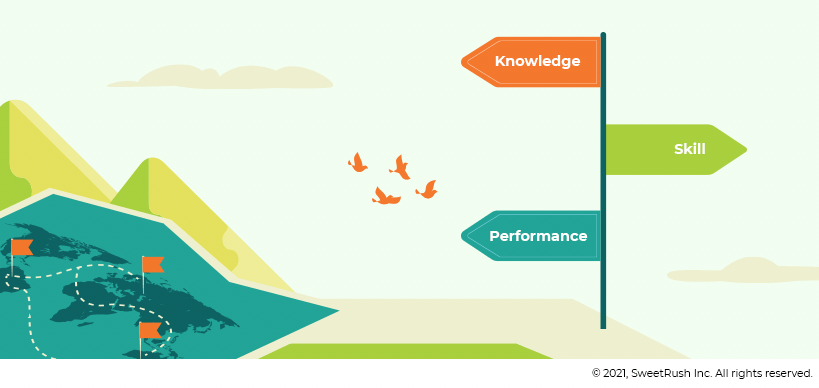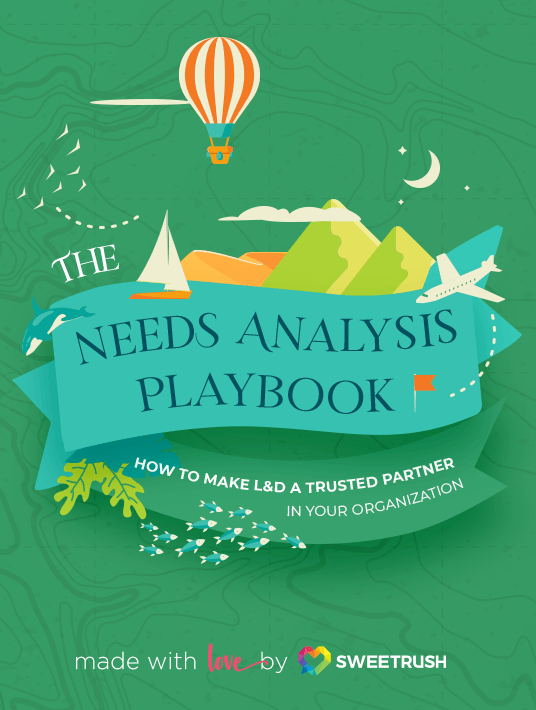Partner With The Business To Pinpoint The Gaps
There are many reasons for training. Some are straightforward, such as the need to teach people new methodologies, processes, tools, or systems. Others are more nuanced, such as a desire to improve leadership skills, customer service, soft skills, or other behavioral areas. All training needs are either about advancing people’s knowledge and skills, or about changing their performance, or both. As L&D professionals, our role is to help pinpoint exactly where the knowledge, skills and performance gaps are so that we can identify the most appropriate way to close them.

Notice I said “help pinpoint”? That’s because we won’t do this in a silo. The needs analysis process—the method we use to pinpoint the gaps—requires input and collaboration from both stakeholders and learners.
Let’s start with stakeholders.

Reveal the Big Picture with a Stakeholder Analysis

Stakeholders usually approach L&D with solutions (e.g., my team needs CRM training) rather than with specific performance issues.
The first step to understanding what the knowledge, skills, or performance gaps are is to take a step back and ask the stakeholders some questions to find out:
What has driven the need? Find out what prompted the stakeholder to approach L&D with this need in the first place. What did they notice about their team’s performance, and what impact is this performance having on the business?
What are the desired outcomes? During needs analysis, ask the stakeholders how the solution will impact the business. What business results should they expect to see after the solution has been implemented. Steer your stakeholder toward measurable or observable outcomes—for example, increase sales pipeline visibility and accuracy, or increase customer experience ratings by 10%.
What should they (the target audience) be doing? Now that you have a little bit more information about what the problem is and what change the stakeholder hopes to see at the business level, you can start drilling down to the specific knowledge, skills, and performance gaps.
And you can do this by asking just one question: “What should they (the target audience) be doing?”
When you ask this question, stakeholders won’t be able to resist also telling you what they are currently doing. And when you know the answer to both of those questions, you’ll have your knowledge, skills, and performance gaps! Bingo!
Whom does this affect? Stakeholders will often tell you that everyone needs training. That’s fair enough when you’re introducing brand new skills or tools. But when the training request is specific to an existing performance problem, it’s really important to establish whom, in particular, it impacts. This can give you clues about what might be causing the problem.
These stakeholder questions should give you what you need to start uncovering the knowledge, skills, and performance gaps. In Chapter 1 of our latest guide, The Needs Analysis Playbook, we take a more detailed look at the stakeholder analysis and provide step-by-step instructions to help you carry out your own needs analysis.
Drill Down into the Details with a Learner Audience Analysis

Consider the stakeholder analysis as the jumping-off point for your needs analysis. For more information about what might be causing knowledge, skills, and performance gaps, you’ll need to go straight to the source and talk to the learners.
Whom should I meet with?
Your goal is to meet with a representative sample of the target learner audience. The larger your audience, the larger the sample should be. Work with stakeholders and managers to identify suitable candidates.
You’ll want to strike a balance between finding more seasoned/experienced individuals to talk to, as well as those who are newer/less experienced. Each group will bring forward different perspectives.

When you’ve identified who is who, arrange separate meetings with each group according to their experience. This is important because newer or less experienced individuals have a tendency to repeat or agree with their more experienced peers, which is not helpful when you are trying to get to the bottom of a specific performance issue.
You need to obtain authentic, reliable insights and data about the performance issues, and not what people think they should be doing—or worse, what they think you want to hear.
Here are the questions to focus on with your learner audience during needs analysis:
What do they already know, and what can they already do?
Find out what the learner audience already knows and what they can do—as well as what, if anything, is enabling or is a barrier to their performance.
- For the performance gaps, you’ll want to find out if the gaps are the same for each learner. And if the gaps are different, what does that look like for each person? What, if anything, might be causing those gaps to be different?
- For the enablers and barriers, you’ll want to find out what, if anything, is helping or hindering their performance. This could include internal factors, such as attitudes, mindsets or beliefs, or external factors such as people, processes, policies, systems, and tools.
What training—formal or informal—have they had or needed, to do this task? When did that training take place? How has it helped? This helps you identify whether training was provided, to whom it was made available, when it was given—and therefore whether different versions exist—and how effective it was.
What, if any, tools or people do they rely on to complete this task? This tells you whether they need additional support—from job aids, or even peers or leaders—to complete the task.
How do they know when the task has been completed correctly? This tells you whether they are able to recognize when a task has been completed successfully—and whether they have clear guidelines in place to help establish this judgment or decision-making.
What is it about the task that they find easy or difficult? This helps you understand where people who are less confident or experienced might be getting stuck.
How would they rate their proficiency and confidence in completing this task? How did they arrive at that conclusion? This helps you to compare and contrast your findings with those gathered from other learners. It will also help you to identify potential SME candidates!
Rather than grill the learners for information—which can put them on edge or make them feel like they are doing something wrong—approach your questions with curiosity. Our new guide, The Needs Analysis Playbook contains tips for framing your questions in a way that doesn’t feel like an interrogation.
These questions should give you a good sense of what the knowledge, skills, and performance gaps are. If you need to dig even deeper, you could use other methods, such as:
- Job shadowing or observation
- Job task inventory
- Leverage of resources such as competency frameworks, standard operating procedures, and guidelines to help compare and contrast expectations vs. reality
One thing to keep in mind throughout the needs analysis process is this: What is causing the gap? And will training, as a stand-alone solution, close the gap, or are additional tools and measures needed to ensure success?
Close the Knowledge, Skills, and Performance Gaps with a Needs Analysis
Effective training is all about closing knowledge, skills, and performance gaps. Before you can close gaps, you need to know what they are. Carry out a needs analysis and seek input from both stakeholders and learners to get to the bottom of what the specific gaps are, whom they are impacting, and what might be causing them.
Do you need more help uncovering performance gaps? Let our eBook, The Needs Analysis Playbook: How to Make L&D a Trusted Partner in Your Organization, be your guide. Packed with advice, tips and tricks, and step-by-step instructions for finding and closing gaps, this invaluable resource will become your trusted companion.










